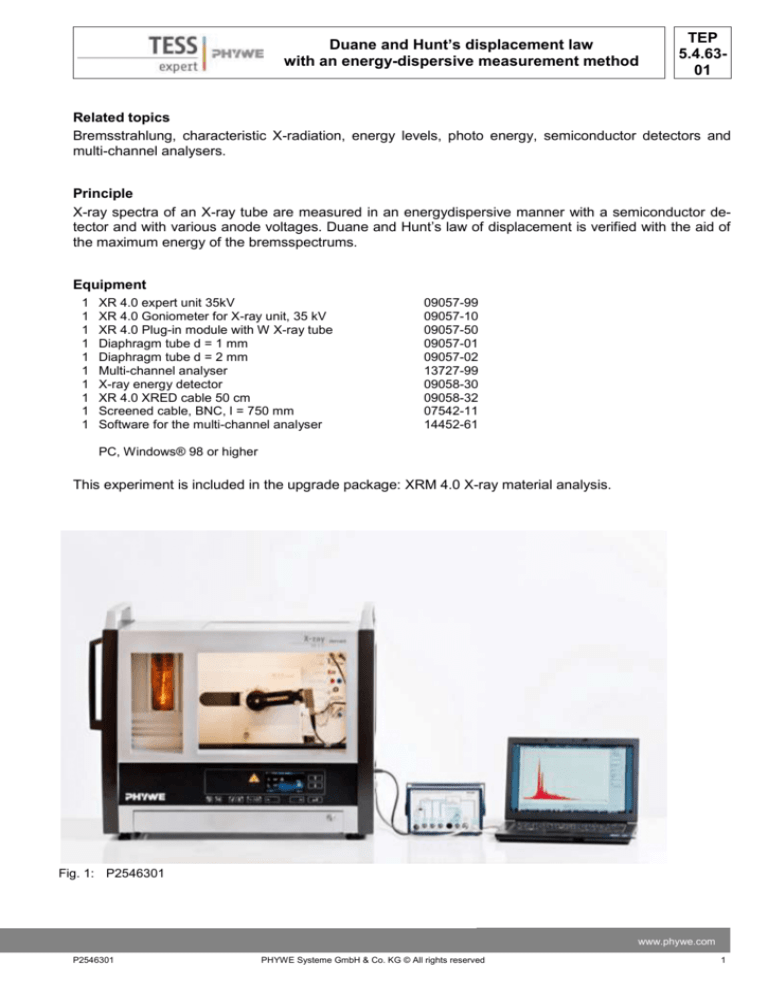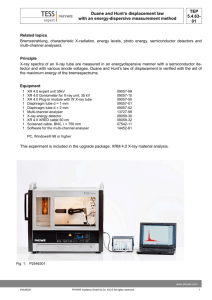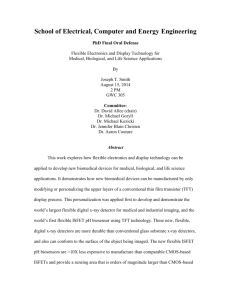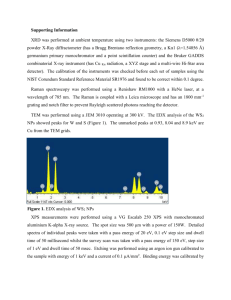
Duane and Hunt’s displacement law
with an energy-dispersive measurement method
TEP
5.4.6301
Related topics
Bremsstrahlung, characteristic X-radiation, energy levels, photo energy, semiconductor detectors and
multi-channel analysers.
Principle
X-ray spectra of an X-ray tube are measured in an energydispersive manner with a semiconductor detector and with various anode voltages. Duane and Hunt’s law of displacement is verified with the aid of
the maximum energy of the bremsspectrums.
Equipment
1
1
1
1
1
1
1
1
1
1
XR 4.0 expert unit 35kV
XR 4.0 Goniometer for X-ray unit, 35 kV
XR 4.0 Plug-in module with W X-ray tube
Diaphragm tube d = 1 mm
Diaphragm tube d = 2 mm
Multi-channel analyser
X-ray energy detector
XR 4.0 XRED cable 50 cm
Screened cable, BNC, l = 750 mm
Software for the multi-channel analyser
09057-99
09057-10
09057-50
09057-01
09057-02
13727-99
09058-30
09058-32
07542-11
14452-61
PC, Windows® 98 or higher
This experiment is included in the upgrade package: XRM 4.0 X-ray material analysis.
Fig. 1: P2546301
www.phywe.com
P2546301
PHYWE Systeme GmbH & Co. KG © All rights reserved
1
TEP
5.4.6301
Duane and Hunt’s displacement law
with an energy-dispersive measurement method
Tasks
1. Record the X-ray spectrum that is emitted by
the tungsten anode for various anode voltages
Ua.
2. Calculate the minimum wavelength of the photons based on the maximum energy of the
bremsspectrums.
3. Represent the relationship between the anode
voltage and the minimum wavelength of the
bremsspectrums graphically.
Set-up and procedure
Set-up (Fig. 1)
- Screw the adapter ring onto the inlet tube of the
energy detector.
- Connect the signal and supply cables to the
corresponding ports of the detector with the aid Fig. 2: Connections in the experimentation area
of the right-angle plugs.
- Connect the signal and supply cables from the
MCA to the appropriate connections in the experiment chamber of the X-ray unit (signal cable: red, supply cable: green (see Fig. 2)).
- Connect the external ports for the X RED of the
x-ray unit (signal cable red, supply cable green,
see Fig. 3) to the multi-channel analyse (MCA).
Connect the signal cable via a screened BNCFig. 3: Connection at the external panel of the XR 4.0 Xcable to the “Input” port of the MCA and the
ray expert unit to the MCA
supply cable to the “X-Ray Energy Det.” port of
the MCA.
- Secure the energy detector in the holder of the
swivel arm of the goniometer. Lay the two cables with sufficient length so that the goniometer can be swivelled freely over the entire swivelling range.
- Connect the multi-channel analyser and computer with the aid of the USB cable.
- Insert the tube with the 2-mm-aperture.
- Bring the goniometer block and the detector to
their respective end positions on the left. Bring
the detector to the 90° position in the 2:1 coupling mode (Fig. 4).
X-ray energy
detector
Calibration of the multi-channel analyser
(if there is no other already existing calibration that
can be used)
- Bring the goniometer block and the detector to
their respective end positions on the right.
- Insert the tube with the 1mm-aperture into the
Fig. 4: Set-up at the goniometer
exit tube of the X-ray tube.
2
PHYWE Systeme GmbH & Co. KG © All rights reserved
P2546301
TEP
5.4.6301
Duane and Hunt’s displacement law
with an energy-dispersive measurement method
-
-
-
-
-
With the X-ray unit switched on and the door
locked, bring the detector to the 0° position.
Then, shift the detector by some tenths degree
out of the zero position in order to reduce the
total rate.
Operating data of the tungsten X-ray tube: Select an anode voltage UA = 25 kV and an anode
current IA = 0.02 mA and confirm these values
by pressing the “Enter” button.
Switch on the X-radiation
In the MEASURE program, select “Multi channel analyser” under “Gauge”. Then, select “Set- Fig. 5: calibration of the multi-channel analyser
tings and calibration”. After the “Calibrate” button has been clicked, a spectrum can be
measured. The counting rate should be < 300 c/s. Energy calibration settings: - 2-point calibration, Unit = keV, Gain = 2 – Set the offset so that low-energy noise signals will be suppressed (usually a
few per cent are sufficient), See Fig 5.
Measuring time: 5 minutes. Use the timer of the X-ray unit.
Make the two coloured calibration lines congruent with the line centres of the two characteristic X-ray
lines. The corresponding energy values (see e.g. P2544701) E(L3M5/L3M4) = 8,41keV and E(L2N4) =
9,69 keV are entered into the corresponding fields, depending on the colour. (Note: Since a separation of the lines L3M5 and L3M4 Lines is not possible, the mean value of both lines is entered as the
energy of the line).
Name and save the calibration.
Measurement of X-ray spectra
In order to verify Duane and Hunt's displacement law, X-ray spectra are measured with various accelerating voltages between 8 kV < UA < 30 kV.
- Use the parameters that were also used for the energy calibration.
- The counting rates should be ≈ 300 c/s. This can be achieved by varying the anode current and by
shifting the detector some tenths degree out of its zero position.
- The measuring time is approximately 3 minutes/spectrum.
- In order to simplify the evaluation of the measurement curves, switch from the bar display to the
curve display. To do so, click “Display options” and then “Interpolation and straight lines”.
-
Use the “Survey
“ function in order to determine the bremsspectrums (see Fig. 2).
Theory and Evaluation
Due to the voltage Ua between the anode and cathode, the electrons are accelerated from the cathode
towards the anode. At the cathode, the electrons have the energy:
E e U a
(1)
Due to interactions with the atoms of the anode material, the electrons gradually lose their kinetic energy, which is converted into a continuous X-ray spectrum (bremsspectrum). If the kinetic energy is lost in
one step, X-rays with a maximum energy Emax and a minimum wavelength λmin are generated. In 1915,
the American physicists Duane and Hunt found that the product of the accelerating voltage, and of the
minimum wavelength, is constant:
www.phywe.com
P2546301
PHYWE Systeme GmbH & Co. KG © All rights reserved
3
TEP
5.4.6301
Duane and Hunt’s displacement law
with an energy-dispersive measurement method
U a min 1,25 10 6 Vm
(2)
The energy equation
Emax e U a h f max h
c
(3)
min
with
Planck's constant
h = 6,626 · 10-34 Js
Speed of light
c = 2,998 · 108 m/s
Elementary charge e = 1,602 · 10-19 As
leads to:
min 1,24 10 6
1
Vm
Ua
(4)
for the shortest wavelength of the X-ray photons.
Task 1:
Figure 6a and 6b show the X-ray spectra of tungsten for two different accelerating voltages. In Figure 6a,
the accelerating voltage is Ua = 9 kV. Since the energy of the L-level of tungsten is approximately 10
keV, it is impossible to generate any characteristic L-lines with this accelerating voltage.
Task 2:
The table below shows the evaluation of the measurement series. Column A includes the anode voltage
values Ua. Column B shows the maximum energy Emax of the associated bremsspectrums. Column C
shows the λmin values that have been calculated in accordance with (3) and with the equivalent 1 eV =
1.6021 · 10-19 J.
Table: Minimum wavelengths of the X-ray photons as a function of the anode voltage
A
B
C
Emax / keV
λmin / pm
UA / kV
30
27
24
21
18
15
12
9
4
29
26,1
23
20,1
17,4
14,7
12
9,2
PHYWE Systeme GmbH & Co. KG © All rights reserved
42,8
47,5
53,9
61,7
71,3
84,4
103,3
134, 8
P2546301
Duane and Hunt’s displacement law
with an energy-dispersive measurement method
TEP
5.4.6301
UA = 9 kV
Emax = 9,2 keV
UA = 18 kV
L-Lines of tungsten
Emax = 17,4 keV
Fig. 6: W-X-ray spectrum with accelerating voltages of a: Ua = 9 kV and b: Ua = 18 kV
www.phywe.com
P2546301
PHYWE Systeme GmbH & Co. KG © All rights reserved
5
TEP
5.4.6301
Duane and Hunt’s displacement law
with an energy-dispersive measurement method
Task 3:
Figure 7 shows the curve of the function λmin = f(1/Ua) with the values of the table. The gradient of the regression line that is also shown is ~1.2 · 10-6 Vm and is in accordance with Duane and Hunt’s displacement law.
Fig. 7: λmin of the photons as a function of 1/ Ua
Note
The existence of a boundary wavelength of the bremsspectrum can only be explained with the aid of
quantum theory and Einstein’s energy relation, since in accordance with the classical electrodynamic
theory, the decelerated (negatively accelerated) electron would generate a photon spectrum with random
frequencies.
6
PHYWE Systeme GmbH & Co. KG © All rights reserved
P2546301






